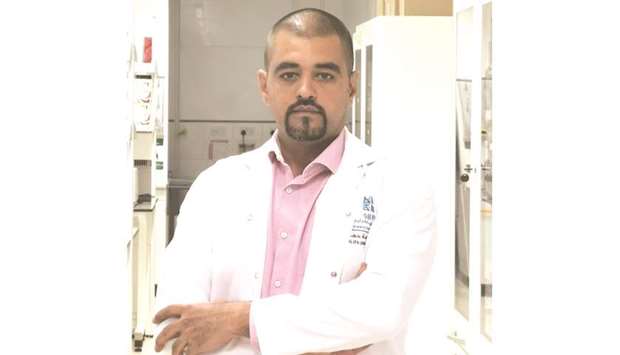Breast cancer in the Arab region has unique characteristics and imposes significant burdens on women, their families, society, and healthcare providers. Among these unique characteristics is the fact that breast cancer tends to affect women at a younger age in Arab countries.
The Cancer Research Centre at Qatar Biomedical Research Institute (QBRI) focuses on cancer biology, immunology and immunotherapy, and has established an inter-disciplinary research programme (IDRP) which is launching this year where a team has been analysing the differences between the various countries in the Middle East and North Africa (Mena) region.
The programme not only aims to gain a molecular understanding of breast cancer in Qatar and the Arab region, but also focuses on developing biomarkers for early diagnosis and screening of breast cancer, predicting disease progression (prognosis), and predicting response to treatments.
As part of the ongoing work within this programme, researchers have analysed the differences between countries in the Mena region using GLOBOCAN 2018, an online database providing estimates of incidence and mortality for 36 types of cancer.
The age-standardised rate – events per 100,000 population – for breast cancer incidence and mortality in 2018 in females of all ages and in age-specific groups was analysed in the Mena subregions, globally, and in the USA and Europe.
In 2018, 78,937 females were diagnosed with breast cancer in the Mena region and breast cancer was the leading cause of cancer diagnosis and mortality in females in each Arab country. However, there were considerable differences across the Mena subregions for breast cancer incidence, mortality, and mortality-to-incidence ratio (MIR).
The Arabian Gulf had the lowest incidence age-standardised rate of 33.0, followed by the African Arab countries (45.8), while the incidence in females in the Levant (Syria, Jordan, Lebanon and Palestine) was higher (70) than the global rate (46.3). The incidence ASR was 84.9 in the USA and 74.4 in Europe.
The MIR – calculated by dividing the number of deaths for a selected cancer type in a given year by the number of newly diagnosed cases for that cancer in the same year – was generally higher in the Mena region than the global figure for 2018.
The MIR for breast cancer for all age groups in the Arabian Gulf was the best (0.29) across the Mena region, and was similar to the global MIR (0.28) but was higher than the USA (0.22) and Europe (0.20). The Levant and Iraq showed lower MIR (0.35) than African Arab countries (0.38), but all were higher for all age groups than the USA, Europe and the global figure. Overall, breast cancer management in the Mena region can be improved for females in all age groups to reach similar figures to those in the USA and Europe.
The age-standardised rate for breast cancer incidence in age-specific groups was also investigated in the Mena subregions, globally, and in the USA and Europe. The conclusion drawn from this analysis is that, compared to the global age-standardised rate, nine of the 19 (47%) Arab countries analysed had higher breast cancer incidence in 2018 in females between 20 and 44 years of age. Those nine are Jordan, Syria, Lebanon, Palestine, Egypt, Sudan, Morocco, Somalia and Algeria. The young age (between 20 and 44) of breast cancer diagnosis in almost half of the Arab countries is most likely due to genetic factors.
Age-standardised rates for breast cancer incidence were obtained from the GLOBOCAN 2018 for females between 20 and 44 years of age. Different age brackets were investigated. Every human has both the BRCA1 and BRCA2 genes – BRCA being the BReast CAncer gene. These genes suppress tumours and their inactivation have been linked to cancer susceptibility. A recent study reported that the Levant region had the highest BRCA mutations prevalence (28%) in hereditary breast and/or ovarian cancer patients compared to the Arabian Gulf and North Africa regions. This is in line with higher breast cancer incidence in young females in the Levant region.
Either due to higher incidence at a younger age in some Arab countries or the younger median age of females in Arab populations, the healthcare systems in Arab countries are expected to encounter younger women affected by breast cancer.
Breast cancer screening (mammograms) are usually done for women aged 45-49 years for earlier diagnosis of breast cancer to improve survival chances. Given the higher incidence in women aged 20-44 years in some Arab countries, mammograms may need to be carried out at a younger age in those countries. Another strategy to prevent late diagnosis, thus worse chances of survival from breast cancer, is genetic screening for cancer-related genes to identify women who should. in consultation with their physician, do check-ups more regularly.
Through the Breast Cancer IDRP starting in 2020, QBRI is collaborating with the country’s Hamad Medical Corporation as well as the King Hussain Cancer Centre in Jordan to analyse blood from familial (hereditary) breast cancer patients with and without BRCA mutations by whole genome sequencing (WGS) to identify other genes implicated in breast cancer in Arabs.
Other molecular profiling such as Ribonucleic Acid (RNA) sequencing will also be carried out. RNA is a polymeric molecule that is essential in various biological roles in coding, decoding, regulation and expression of genes. Other profiling to be carried out in the IDRP include proteomics, metabolomic and others on blood and tissue from breast cancer patients.
The ultimate goal of IDRP is to develop tailored diagnostics to enable personalised treatment and management of breast cancer in Arab populations. Underpinning this vital scientific research, QBRI’s IDRP also aims to alleviate some of the burdens associated with breast cancer.
Dr Fares al-Ejeh is a senior scientist at Qatar Biomedical Research Institute, part of Hamad Bin Khalifa University. He leads a research group focusing on translational research in breast cancer, where he is developing diagnostics and targeted therapies against aggressive breast cancer using integrative and interdisciplinary approaches.

Dr Fares al-Ejeh, senior scientist at Qatar Biomedical Research Institute.


